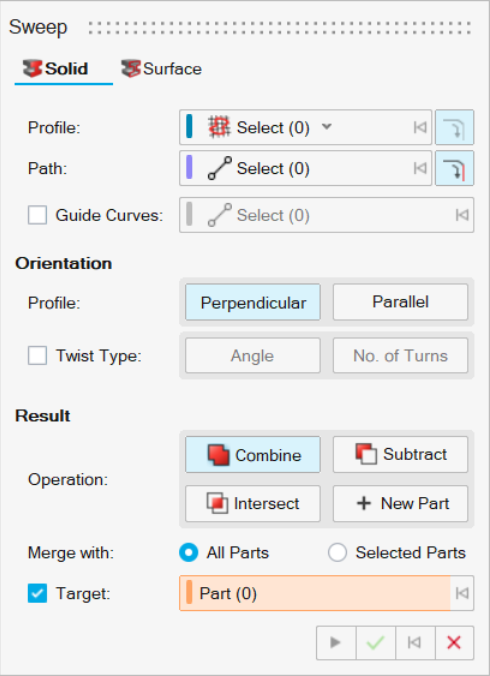Sweep
Sweep a profile along a path to create a solid or surface. Create a new part or combine, subtract, or intersect the swept shape with existing parts.
-
On the Geometry ribbon, select the
Sweep tool.

Note: The tool may be hidden in the dropdown menu. To access the dropdown menu, you can do one of the following:- Select
 at the lower right corner of the
currently displayed tool.
at the lower right corner of the
currently displayed tool. - Click and hold the currently displayed tool.
Tip: To find and open a tool, press Ctrl+F. For more information, see Find and Search for Tools.The guide panel appears.Figure 1. Guide panel using a sketch or planar surface 
Figure 2. Guide panel using a solid body 
- Select
-
Choose the entity type that you'd like to create:
- Solid: Sweep as a solid.
- Surface: Sweep as a surface.
-
Select a Profile. By default,
Select is automatically turned on. Do one of the
following:
- If you selected Solid in the last step, click the
Select collector and select a closed sketch
or a planar surface.
Alternatively, click the down arrow next to the collector to select the Tool collector and select a solid body.
- If you selected Surface in the last step, select a planar edge, closed/open sketch, or a planar surface.
- (Optional): Select
 so that clicking an edge will also select
edges connected to the profile.
so that clicking an edge will also select
edges connected to the profile.
Note: To deselect, hold down Ctrl while clicking. - If you selected Solid in the last step, click the
Select collector and select a closed sketch
or a planar surface.
-
Choose a Path:
-
Choose the Type of sweep:
- No Guide Curves: Don't use guide curves. You can add a twist to the swept shape.
- Guide Curves: Add one to two guide curves. This
allows you to refine the swept shape, but you can’t add a twist.
- Next to Guide Curves, click the Select button, then select one or two guide curves, which must coincide with the profile. To deselect, hold down Ctrl while clicking.
-
Choose a Profile orientation:
- Perpendicular (default): Orient the swept shape perpendicular to the path.
- Parallel: Orient the swept shape parallel to the path.
-
(No Guide Curves only) Choose a Twist Type:
- None: Don’t add a twist to the swept shape.
- Angle: Add a twist the swept shape by defining the twist angle. After selecting this option, you can enter the Twist Angle and select Reverse Twist Direction.
- No. of turns: Add a twist to the swept shape by defining the number of turns. After selecting this option, you can enter the No. of Turns and select Reverse Twist Direction.
-
(Guide Curves only) Choose a Scale:
- Uniform: Scale the profile along both the X and Y directions.
- Lateral: Scale the profile only along the X direction, stretching it along the path and guide curves while maintaining the Y direction.
-
(Tool only) Choose Lock Direction settings.
- Lock Direction: Select to lock the direction of the sweep along a defined path. For example, when sweeping along a helix, locking the direction prevents the tool from rotating in both directions of the helix.
- Click the Lock Direction collector and click the direction the sweep should follow.
-
Choose a Result type:
- Combine/Merge: Combine or merge the extruded shape with the existing parts.
- Subtract (only available for Solids): Carve out the extruded shape from the existing parts.
- Intersect (only available for Solids): Retain only the intersecting portions of the extruded shape and the existing parts.
- New Part: Create a new part from the extruded shape.
-
Choose a Merge method:
- All Parts (default): Merge the extruded shape with all parts that touch the extruded shape.
- Selected Parts: Select the radio button to merge the extruded shape with selected parts. Then select the parts that you’d like to merge the extruded shape with.
-
If you selected Combine, choose how to combine the swept
shape:
- Target: Select the checkbox and use the collector
to select the part you want to merge into.Note: When the Selected Parts radio button is selected, the target part must be one of the selected parts before you can apply the change. When All Parts is selected, you can select any part as the Target.
- Target: Clear the checkbox to merge parts automatically.
- Target: Select the checkbox and use the collector
to select the part you want to merge into.
-
Edit a profile. (only available for Surfaces)
- Select the profile.
- You can then do the following:
To Do this Note If surface edges were used for profiles or guide curves, modify the constraint to fine-tune the shape of the sweep In the microdialog, select a Constraint type: - None: Don't constrain the sweep.
- Surface: The swept shape is made tangent to the surface edge.
- Magnitude: Change the magnitude of the constraint for the selected profile.
To invert the direction of the profile's tangent, select Invert Tangent
 .
.Change the tangent magnitude for the profile In the microdialog, enter the Magnitude. Invert the orientation of the profile Invert Orientation The direction of the arrow on the profile indicates its orientation. In most cases, the optimal orientation of each profile is internally calculated so that the resulting surface is not twisted. In some cases, inverting a profile's orientation will cause the sweep to fail. - Click Apply.
- Right-click and mouse through the check mark to exit, or double-right-click.